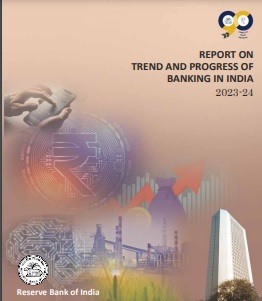To decide the appropriate AFA for a transaction, a risk-based approach needs to be adopted based on factors like the risk profile of the customer and / or beneficiary, transaction value and channel of origination

FinTech BizNews Service
Mumbai, 27 December, 2024: The Reserve Bank of India released its “Report on Trend and Progress of Banking in India 2023-24” on 26 Dec, 2024.
Payment and Settlement Systems
The Reserve Bank has been a pioneer in establishing various technology-based solutions for improvement of the payment and settlement system infrastructure, coupled with the introduction of innovative payment products. The global reach of unified payments interface (UPI), India’s fast payment system (FPS), is steadily growing through partnerships with various countries.
Bharat Bill Payment System (BBPS)
BBPS, an integrated bill payment system, offers interoperable and convenient payment services to customers. In view of the evolving payment ecosystem, the Reserve Bank issued a revised regulatory framework on February 29, 2024. Some of the key changes include, inter alia, expanding the participation criteria to all authorised non-bank payment aggregators; measures to enhance interoperability; customer protection measures and requirement of escrow account for non-bank Bharat Bill Payment Operating Units (BBPOUs).
Framework on Alternative Authentication Mechanisms for Digital Payment Transactions
On July 31, 2024 the Reserve Bank released draft framework on alternative authentication mechanisms for digital payment transactions. As per the framework, all digital payment transactions shall be authenticated with additional factor/s of authentication (AFA), wherein one of the factors of authentication should be dynamically created. Additionally, to decide the appropriate AFA for a transaction, a risk-based approach needs to be adopted based on factors like the risk profile of the customer and / or beneficiary, transaction value and channel of origination.
Cyber Resilience and Digital Payment Security Controls for Non-Bank Payment System Operators (PSOs)
On July 30, 2024 the Reserve Bank issued directions to non-bank PSOs, aimed at enhancing their information security preparedness and cyber resilience. The directions will be applicable to all authorized non-bank PSOs and will be implemented in a phased manner, starting with large entities effective April 1, 2025.
Pre-sanctioned Credit Lines through UPI
In September 2023 the Reserve Bank had allowed pre-sanctioned credit lines to be linked through UPI and be used as a funding account by SCBs excluding PBs, SFBs and RRBs. On December 6, 2024, the Reserve Bank announced that SFBs would also be permitted to extend this facility. This will further deepen financial inclusion and enhance formal credit, particularly for ‘new to credit’ customers. 9. Overall Assessment III.51 The financial landscape is witnessing a dramatic transformation, globally as well as in India, driven by technological innovations, changing consumer preferences and emergence of alternative business models. While these developments have fostered competition and collaboration, they also raise concerns about customer security and adequate regulatory oversight.
During 2023-24 and 2024-25, the Reserve Bank continued to pursue proactive and prudent regulatory and supervisory policies with focus on strengthening resilience of REs, consumer protection, grievance redress mechanisms, financial inclusion, mitigation of climate risks, digitalisation and promoting innovation. The robust financial health of REs enabled them to fund productive activities of the economy, while embracing technology. The Reserve Bank remains committed to preserving financial stability and enhancing financial sector efficiency, while adopting a consultative approach in its regulatory frameworks and aligning Indian banking practices with international standards. The objective is to shape a resilient financial sector through a flexible and robust regulatory architecture so as to foster growth with stability.